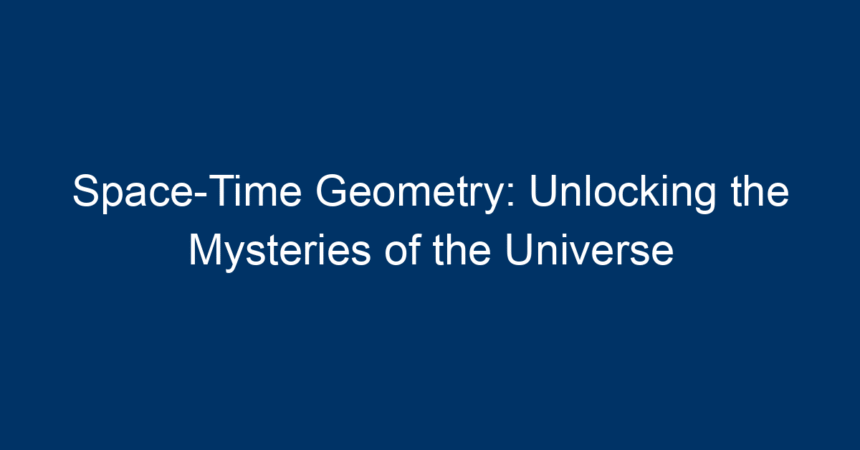Introduction
The cosmos has fascinated humanity for centuries, beckoning us to uncover its secrets. Among the most profound concepts in modern physics is space-time geometry, which provides a framework for understanding the universe’s structure and intricacies. This article delves into the fundamentals of space-time geometry, its implications in physics, and how it continues to unravel the mysteries of existence.
What is Space-Time Geometry?
At its core, space-time geometry combines the three dimensions of space with the fourth dimension of time into a single four-dimensional continuum. Albert Einstein’s theory of relativity revolutionized our understanding of how gravity affects this geometry, leading to profound implications for physics, cosmology, and our perception of reality.
The Foundations of Space-Time
-
Understanding Space and Time
- Space and time are traditionally viewed as separate entities. However, space-time geometry reveals their interdependent nature. Time, far from being a mere backdrop, actively interacts with spatial dimensions, shaping the fabric of the universe.
- Einstein’s Theory of Relativity
- Einstein’s special and general theories of relativity laid the groundwork for understanding space-time geometry. The equation (E=mc^2) illustrates the relationship between energy and mass, indicating that mass can warp the space-time continuum. This warping is crucial for understanding gravitational forces.
The Geometry of Space-Time
-
Curvature of Space-Time
- Objects with mass, like planets and stars, cause a curvature in space-time. This curvature explains why objects fall toward each other — they are simply following the paths dictated by the distorted geometry around them.
- Geodesics: The Shortest Path
- In space-time, the “straightest” path between two points is known as a geodesic. While we often think of this in a flat surface context, space-time geodesics are curved, illustrating how gravity influences motion.
Applications of Space-Time Geometry
-
Black Holes and Singularities
- Black holes, once mere theoretical constructs, can now be studied through the lens of space-time geometry. A black hole represents a point where mass condenses infinitely, creating an area of extreme curvature in space-time known as a singularity.
- Time Dilation
- Time dilation is a fascinating outcome of space-time geometry, particularly evident in scenarios involving high speeds or strong gravitational fields. As one approaches the speed of light or a massive object’s gravitational pull, time appears to slow down relative to an outside observer, leading to intriguing implications for space travel.
The Role of Quantum Mechanics
While space-time geometry provides a classical understanding of the universe, it often encounters challenges when paired with quantum mechanics. The interplay between the two is a crucial area of contemporary research, particularly in understanding gravity’s quantum nature and the quest for a unified theory.
- Quantum Gravity
- One of the major unsolved problems in physics is reconciling general relativity, which uses space-time geometry, with quantum mechanics. Theoretical frameworks like string theory and loop quantum gravity aim to merge these perspectives, potentially leading to a more comprehensive understanding of the universe.
Real-World Implications
-
GPS Technology
- The effects of space-time geometry are not just theoretical; they have practical applications. GPS satellites must account for time dilation attributed to their speeds and the gravitational effects of Earth to deliver accurate location data.
- Understanding the Universe’s Expansion
- Space-time geometry offers insights into the expanding universe, leading to the discovery of dark energy. This mysterious force is thought to drive the acceleration of the universe’s expansion, a critical factor in cosmological studies.
Future Directions in Space-Time Research
The exploration of space-time geometry is far from complete. Here are some promising avenues for future research:
-
Exploring Dark Matter and Dark Energy
- Much of the universe remains a mystery, with dark matter and dark energy constituting significant portions of the cosmos. Research into space-time geometry could offer clues regarding these elusive components.
- Advancements in Theoretical Physics
- As scientists continue to probe the realms of high-energy physics, the interplay between space-time geometry and emerging theories will likely yield new understandings of the fundamental structure of reality.
Conclusion: Unlocking the Mysteries of the Universe
Space-time geometry serves as a gateway to understanding the universe’s fundamental workings. From explaining gravity’s role in our daily lives to shaping our comprehension of dark matter, it offers powerful insights into the fabric of reality. As scientists continue to explore this enigmatic domain, we are reminded that every discovery paves the way for new questions.
Actionable Insights
-
Stay Informed: Follow current research and advancements in physics. Books, documentaries, and online courses can provide new perspectives on complex topics.
-
Engage with Science Communities: Connecting with forums or local science groups can inspire curiosity and deeper understanding of concepts like space-time geometry.
- Explore Further Reading: Titles such as "A Brief History of Time" by Stephen Hawking and "The Elegant Universe" by Brian Greene delve into space-time and its implications.
In understanding space-time geometry, we not only unlock secrets of the universe, but also foster a deeper connection with the cosmos and our place within it.




